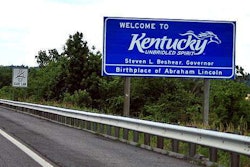 The bridge over Catawissa Creek for PA 339 through the Village of Zions Grove is one of the 58 bridges to be replaced as part of Pennsylvania’s Rapid Bridge Replacement Program.
The bridge over Catawissa Creek for PA 339 through the Village of Zions Grove is one of the 58 bridges to be replaced as part of Pennsylvania’s Rapid Bridge Replacement Program.The American Road & Transportation Builders Association’s (ARTBA) recent analysis of the Federal Highway Administration’s (FHWA) 2015 National Bridge Inventory shows there were 2,574 fewer structurally deficient bridges in the U.S. compared to 2014.
But the group emphasizes that there are still 58,500 bridges in that condition, and estimates at current bridge investment levels it would take more than 21 years before they are all replaced or upgraded.
“Every year we have new bridges move on the list as structures deteriorate, or move off the list as improvements are made,” says Dr. Alison Premo Black, ARTBA’s chief economist.
Black provided the analysis of the bridge inventory and found there were 4,625 structurally deficient bridges that were not classified as such in 2014. However, she found that roughly 7,200 bridges that were structurally deficient that year had been repaired, replaced, rebuilt or removed from the 2015 inventory.
Black believes the FAST Act signed last year “provides a modest increase” for bridge repair funding, but it isn’t enough to make possible an “accelerated” bridge repair program across the country.
“It’s going to take major new investments by all levels of government to move toward eliminating the huge backlog of bridge work in the United States,” she says.
ARTBA’s 2015 bridge report is available at www.artbabridgereport.org and FHWA’s 2015 National Bridge Inventory, as well as past reports, are available here.
Our 2015 Better Roads Bridge Inventory report, with an interactive map providing number of bridges in both structural deficient and functionally obsolete condition for each state, is available here.









